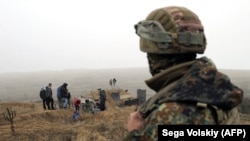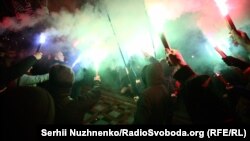On Monday, November 26, Ukrainian President Petro Poroshenko signed a decree to introduce martial law for 60 days, tentatively scheduled to start from 9 am (local time), November 28 .
Following strong public reaction on Monday, Poroshenko announced he would halve the term of military rule from 60 to 30 days.
Parliamentary approval for martial law was granted on Monday evening.
Poroshenko said, martial law does not mean a “declaration of war,” adding that “Ukraine has no plans to go to war with anyone.”
In a statement prior to the parliamentary vote, Poroshenko said that martial law would be introduced “exclusively for the purposes of defense, protection of the Ukrainian land, our territorial integrity, our country's sovereignty and independence."
That announcement came after three Ukrainian ships were fired upon and then captured by Russian vessels as the Ukrainians were preparing to transit through the Kerch Strait, from the Black Sea port of Odessa to Mariupol in the Sea of Azov on Sunday, November 25.
Earlier that day, a Ukrainian tugboat was rammed by a Russian coast guard ship.
In a statement released on Monday, November 26, Poroshenko said, the attack was not “accidental.”
“Russia has been waging a hybrid war against our country for five years. But with an attack on Ukrainian military boats it moved to a new stage of aggression. No one will say now: ‘They are not there’. No one camouflages into green humanoids or militiamen. This is a bold and frank participation of the regular units of the Russian Federation, their demonstrative attack on the detachment of the Ukrainian Armed Forces. This is a qualitatively different situation, a qualitatively different threat,” he said.
Poroshenko said the latest incident in the Sea of Azov was likely not the “culmination” of hostilities there.
Reacting to the evolving situation, Bogdan Bespalko, a member of the Russian Presidential Council for Inter-ethnic Relations, said that martial law could be used as a pretext to “strengthen Ukraine’s isolation from Russia.”
He also said it could “entail a series of possible infringements of the rights and freedoms of citizens and restrictions, the possibility of the seizure of property, vehicles and fund for the state and army.”
His overall claim that radical changes are possible is correct.
As noted in the Kyiv Post, the Ukrainian parliament or the Verkhovna Rada passed a bill “On the Legal Regime of Martial Law” in 2015.
Under that law, potential measures cover everything from a wholesale ban on elections, to referendums and constitutional changes; a prohibition against peaceful protest, gatherings and other mass events; a halt to political activity deemed “detrimental to state security;” curfews; forced evacuations; a ban on selling alcohol; a requirement for civilians to provide quarters to military personnel or displaced individuals; forced internment or relocation of foreign citizens who pose a threat; and additional measures to safeguard state secrecy.
The decree also allows for mobilizing reserve forces, organizing the air defense around vital state facilities and ramping up cyber security defenses.
While Poroshenko reportedly said, “Russia is preparing a ground attack against Ukraine,” necessitating martial law, he is not characterizing it as a “declaration of war or mobilization.”
Also on Monday, Secretary of the National Security and Defense Council of Ukraine, Oleksandr Turchynov, said that martial law “may be lifted at any time if the situation normalizes.”
According to Kyiv-based RFE/RL correspondent Christopher Miller, "martial law will not cover Ukraine entirely, but regions subject to 'Russian aggression,' including Vinnytsia, Luhansk, Mykolayiv, Odesa, Sumy, Kharkiv, Chernihiv, Kherson, Sea of Azov."
Some within the Radical Party and The All-Ukrainian Union "Fatherland" or Batkivshchyna party had reportedly sought to block the introduction of martial law, with observers in Ukraine noting they could be the biggest losers if Presidential and parliamentary polls, scheduled in four months, are pushed back.
Writing for Hromadske news site in August, special correspondent for international coverage, Maksym Kamenev said that Poroshenko’s support rate “fluctuates between 5% and 8%, while Batkivshchyna party head and former Prime Minister Yulia Tymoshenko “leads the polls with 10-13% of the votes.”
The Russian state outlet, RT, has suggested that invoking martial law should be beneficial for Poroshenko, since “the president’s rating is falling as he struggles to campaign for re-election in March.”
But the final vote on martial law saw 276 for and 30 votes against (with 23 not voting and 1 abstaining).
Poroshenko said martial law will not “overlap with the beginning of the election campaign by a single day.”
“Martial law will last 30 days and will end in mid-December. It is in December, in early December, that I will submit a draft resolution to the Parliament on the date of the presidential elections to be held in accordance with the Constitution on March 31, 2019. Period. As Supreme Commander-in-Chief, I will make every effort to stay within this short term and squeeze out the maximum opportunities from this month to increase our readiness to repel a possible full-scale offensive of the aggressor country – Russia,” he said.
For now, while Polygraph.info finds that Russian council member’s proclamations on the potential of martial law in Ukraine are consistent with the context of the country’s basic law, the extent to which it will be used and its implications appear to be limited and so the final effects are unclear.








